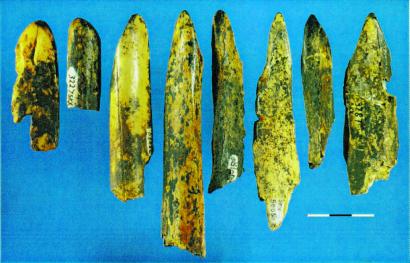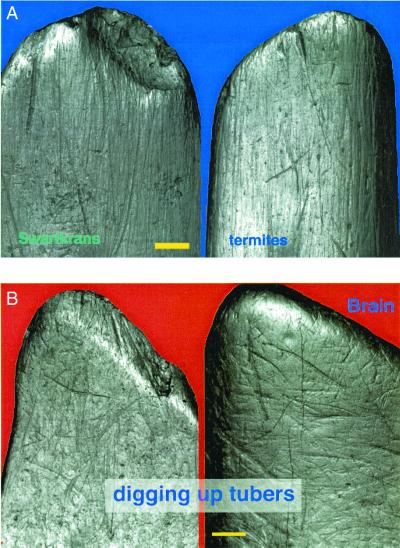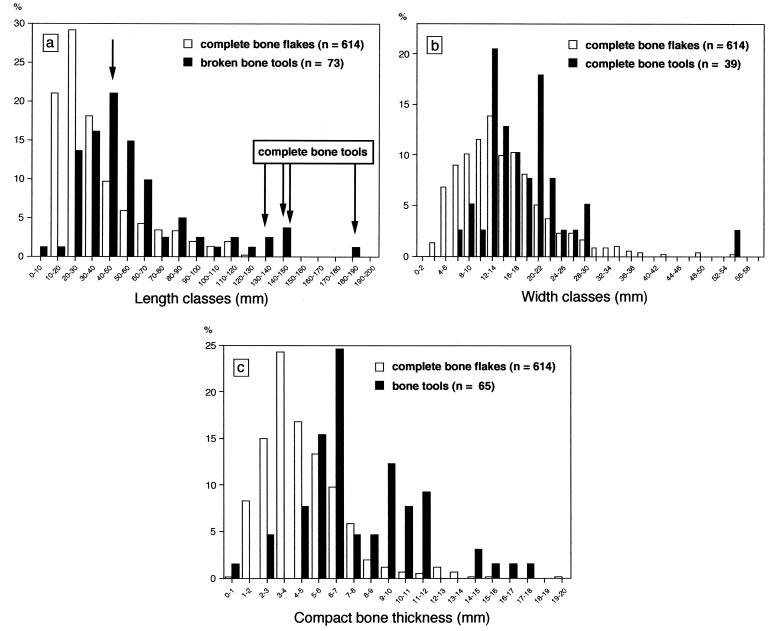Taphonomy can be defined as the study of the laws of destruction and burial that intervene between living communities and fossilized ones (1), but it is more an attitude than a proper discipline. Over the last 30 years, taphonomy has emerged as a concentration and set of techniques at the interface of archaeology, paleontology, biological anthropology, and ecology. The fundamental taphonomic question is: what agent or agencies collected and modified a bone assemblage? The task is to deduce how particular bones came to be fossilized in a particular geological setting together and in the state of completeness or preservation in which they were found. One of the main aims of taphonomic studies has been to establish whether hominids (human ancestors and their close kin) were instrumental in creating and modifying the assemblage in question or whether its features can better be explained by the action of natural agencies: carnivores, wind, water, trampling animals, sedimentary abrasion, and the like (2–4).
Taphonomy is especially pertinent in the evaluation of putative early bone tools that have been minimally modified and then often only by use as opposed to modification for use (5, 6). Unambiguous examples of bone expediency tools are rare and precious. In contrast, from about 2.6 million years onward, hominids apparently littered the landscape with readily recognizable flaked stone tools and the debris resulting from their manufacture and use (e.g., refs. 7 and 8). Even the crudest tools are far easier to identify than bone tools of comparable sophistication, partly because stone and bone have very different material properties. As a raw material, stone has the infinite advantage of being enduring and inedible. Only the very largest bones from the biggest animals (the shafts of the major limb bones of elephants, giraffe, hippos, and the like) are amenable to flaking and even these may be subject to natural forces of destruction. Thus, the report by Backwell and d'Errico (9) in this issue of PNAS, outlining new techniques for recognizing bone expediency tools and their conclusion that termite extraction was one of the uses of such tools in the period between 1 million and 2 million years ago, is doubly noteworthy.
Backwell and d'Errico have focused on characterizing use wear—the modification of a broken or intact bone surface by the process of use—as the best means of identifying expediency tools. Although this is not a new approach, Backwell and d'Errico have made substantial progress in the analysis of possible bone tools at the early hominid sites of Swartkrans and Sterkfontein in South Africa, surpassing previous work, including studies done of the same specimens by C. K. Brain and myself (3, 10–12). Some 10 years ago, Brain and I examined high-fidelity replicas of the apparent working ends of 69 possible bone tools from hominid-bearing layers at Swartkrans and Sterkfontein, dated to between 1.8 million and 1.1 million years ago, using the scanning electron microscope. We found and photographed clear use wear on these pieces that was closely confined to the tips and that differed from the rounding and smoothing produced by a variety of natural agencies, suggesting that these objects were indeed bone expediency tools. Based on very limited experiments using similar pieces of modern bone, we suggested that the wear on these fossil bone tools best matched that on bone splinters or horncores that had been used in digging tubers in the rocky soils surrounding the South African cave sites. In our view, these objects were a bony equivalent of a digging stick, a very useful object in a region short on trees. Backwell undertook a much broader taphonomic study of all 23,000 specimens from Swartkrans, which resulted in the identification of 16 additional long bone fragments with apparent use wear, bringing the sample of purported bone tools to 85. As an aid to interpreting the various taphonomic agents that had affected different parts of the entire sample, she also studied 35 reference collections of fossil and modern bones of known history. These reference samples included a total of more than 13,000 bones modified by 10 nonhuman agencies (hyena, dog, porcupine, leopard, cheetah, river gravel, spring water, flood plain activities, wind, and trampling) and bones used experimentally in digging bulbs and tubers, piercing and scraping animal hides, and breaking into termite mounds to induce swarming of the inhabitants.
Working with d'Errico, she then compared the microscopic effects of these known taphonomic agents to the attributes of the 85 putative bone tools from Swartkrans and Sterkfontein. In addition to describing the wear or damage on the rounded tips, they measured the basic dimensions of the fragments or bones and documented the orientation and placement of scratches or striations on the specimens, using image analysis software. As had Brain and I, Backwell and d'Errico found differential wear on the purported tools that was concentrated close to the single, rounded tip (Fig. 1). They also observed that striations or scratches ranging in width from 5 to 40 microns covered the polished surface, but diminished in frequency until they were entirely absent from areas of the bones more than 50 mm from the tip. No nonhuman taphonomic agency in their reference samples produced modifications matching these features.
Figure 1.
A macro photo of the bone tools. [Reproduced with permission from the supplemental material of ref. 9 (Copyright 2001, National Academy of Sciences).]
Somewhat surprisingly, Backwell and d'Errico showed that there was a statistically meaningful difference between the orientation of the scratches produced by digging for tubers and those created during opening up of termite mounds (Fig. 2). The orientation of the scratches as well as the nonmetric aspects of use wear on the fossil specimens very closely resembles the pattern seen on termiting tools. Thus, Backwell and d'Errico are able to conclude with considerable confidence that early South African hominids used pointed bones, horncores, and bone fragments to catch and presumably eat termites, a rich source of protein and fat.
Figure 2.
(Upper) A Swartkrans bone tool and a termiting tool. (Lower) The tuber-digging tools. The use wear on the Swartkrans fossil more closely resembles that on the experimental termiting tool than the use wear on these tuber-digging tools. [Reproduced with permission from the supplemental material of ref. 9 (Copyright 2001, National Academy of Sciences).]
They also were able to show that bones or bone fragments were not chosen randomly. Long, straight bone splinters or horncores 13–19 cm in total length were favored. And although many of the bone termiting tools were broken after fossilization, metric analysis of the complete ones shows that they are longer, wider, and thicker (in terms of cortical bone) than the unutilized sample of comparable fragments from Swartkrans (Fig. 3). This finding suggests that the hominids wittingly or unwittingly selected bones of a particular size, shape, and durability for use in termiting. Not surprisingly, comparable selectivity has been observed in termiting tools used by chimpanzees.
Figure 3.
A composite of the three graphs from Backwell and d'Errico (9) showing length, width, and thickness differences between the bone tools and the other fossil fragments. [Reproduced with permission from the supplemental material of ref. 9 (Copyright 2001, National Academy of Sciences).]
In the many thousands of pages (e.g., refs. 13–15) that have been expended on the components of early hominid diet(s), insectivory has rarely received much attention. Thus, finding evidence that early hominids at Swartkrans and Sterkfontein apparently regularly used bone tools to collect termites is a remarkable discovery. That termites were available is proven by the fauna preserved at Swartkrans in the same layers, which includes at least three different mammalian species that are termite-eating specialists: aardwolf, aardvark or antbear, and pangolin (16). Most compellingly, this finding explains some peculiar results obtained by recent isotopic analyses (17, 18) of bones of the two hominids present at these sites, Australopithecus robustus and Homo. It is widely accepted that these two contemporaneous hominids differed in their diets. The consensus is that Homo probably ate more meat (whether obtained by hunting or scavenging) than A. robustus, which seems adapted for eating large quantities of low-quality vegetarian food with its large, flat teeth and massive chewing muscles. However, the isotopic analysis of the robust australopithecine bones from Swartkrans showed a surprisingly high proportion of C4 dietary carbon, indicating a substantial intake of protein remarkable for a vegetarian species. Among the species of known diet that were analyzed as controls in this study was the termite-eating aardvark, which had an isotopic signal very similar to that for A. robustus.
On the basis of the isotopic work alone, few were willing to speculate that A. robustus was a specialist in termite eating. With the additional evidence from the ingenious work of Backwell and d'Errico, it seems irresistible to conclude that robust australopithecines may have relied on termites seasonally or even year-round, in addition to vegetable foods. As-yet-undescribed but similarly worn bone fragments from the South African site at Drimolen (19) hint that termite extraction might have been a more widespread and important dietary behavior for early hominids.
It is important to note that exactly which hominid made and used the bone tools for termiting in these South African sites cannot be definitively established. Two species of hominid are present at Swartkrans, Sterkfontein, and Drimolen and there is no solid ground for selecting one over the other. Too, the simple co-occurrence of a species with tools cannot convincingly identify the toolmaker. For example, I conducted a study of the co-occurrence of stone tools and cutmarked bones with various species in the assemblages from Olduvai Beds I and II and found strong support for the absurd conclusion that a medium-sized antelope was the toolmaker (20).
If we accept that these are bone termiting tools from Swartkrans and Sterkfontein (and possibly Drimolen), the obvious question is whether comparable behaviors existed at Olduvai and other East African sites sampling the same time period. If not, termiting may have been a local phenomenon among South African hominids that did not spread to their relatives farther north. Although extensive research on the Olduvai bone assemblages by M. D. Leakey (21) and many later workers (e.g., refs. 6, 11, 20, 22, and 23) has never turned up possible bone tools that resemble the South African termiting tools, I, for one, would strongly encourage an examination of those materials by Backwell and d'Errico. With their new and more stringent criteria for recognizing such tools, it is time to see what might have been overlooked in the past.
Footnotes
See companion article on page 1358.
References
- 1.Efremov J A. Pan-Am Geol. 1940;74:81–93. [Google Scholar]
- 2.Shipman P. Life History of a Fossil: An Introduction to Taphonomy and Paleoecology. Cambridge, MA: Harvard Univ. Press; 1981. [Google Scholar]
- 3.Brain C K. The Hunters or the Hunted? An Introduction to African Cave Taphonomy. Chicago: Univ. of Chicago Press; 1981. [Google Scholar]
- 4.Bonnichsen R, Sorg M, editors. Bone Modification. Orono: Univ. of Maine; 1989. [Google Scholar]
- 5.Johnson E. In: Advances in Archaeological Method and Theory 8. Schiffer M B, editor. New York: Academic; 1985. pp. 157–235. [Google Scholar]
- 6.Shipman P, Rose J. In: The Scanning Electron Microscope in Archaeology. Olsen E L, editor. Oxford: British Archaeological Reports; 1988. pp. 303–335. [Google Scholar]
- 7.Schick K D, Toth N. Making Silent Stones Speak. New York: Simon & Schuster; 1993. [Google Scholar]
- 8.Harris J W K. Afr Arch Rev. 1983;1:3–31. [Google Scholar]
- 9.Backwell L R, d'Errico F. Proc Natl Acad Sci. 2001;98:1358–1363. doi: 10.1073/pnas.021551598. . (First Published January 16, 2001; 10.1073/pnas.021551598) [DOI] [PMC free article] [PubMed] [Google Scholar]
- 10.Brain C K, Shipman P. In: Swartkrans: A Cave's Chronicle of Early Man. Brain C K, editor. Pretoria: Transvaal Museum Monograph; 1993. pp. 195–215. [Google Scholar]
- 11.Shipman P. In: Bone Modification. Bonnichsen R, Sorg M, editors. Orono: University of Maine; 1989. pp. 317–334. [Google Scholar]
- 12.Brain C K, Churcher C S, Clark J D, Grine F E, Shipman P, Susman R L, Turner A, Watson V. S Afr J Sci. 1988;84:828–835. [Google Scholar]
- 13.Aiello L, Wheeler P. Curr Anthropol. 1995;36:199–221. [Google Scholar]
- 14.Walker A. Philos Trans R Soc London B. 1981;292:57–64. doi: 10.1098/rstb.1981.0013. [DOI] [PubMed] [Google Scholar]
- 15.Grine F. S Afr J Sci. 1981;77:203–230. [Google Scholar]
- 16.Watson V. In: Swartkrans: A Cave's Chronicle of Early Man. Brain C K, editor. Pretoria: Transvaal Museum Monograph; 1993. pp. 35–73. [Google Scholar]
- 17.Sponheimer M, Lee-Thorpe J A. Science. 1999;283:368–370. doi: 10.1126/science.283.5400.368. [DOI] [PubMed] [Google Scholar]
- 18.Lee-Thorpe, J. A., Thackeray, F. J. & van der Merwe, N. J. (2001) J. Hum. Evol., in press. [DOI] [PubMed]
- 19.Keyser A, Menter C G, Moggi-Cecchi J, Pickering T R, Berger L R. S Afr J Sci. 2000;96:193–197. [Google Scholar]
- 20.Shipman P. In: The Scanning Electron Microscope in Archaeology. Olsen E L, editor. Oxford: British Archaeological Reports; 1988. pp. 261–286. [Google Scholar]
- 21.Leakey M D. Olduvai Gorge, Vol. III: Excavations in Beds I and II, 1960–1963. Cambridge, U.K.: Cambridge Univ. Press; 1971. [Google Scholar]
- 22.Potts R. Early Hominid Activities at Olduvai. New York: de Gruyter; 1988. [Google Scholar]
- 23.Bunn H T. Evidence on the Diet and Subsistence Patterns of Plio-Pleistocene Hominids at Koobi For a, Kenya, and at Olduvai Gorge, Tanzania. Oxford: British Archaeological Reports; 1983. [Google Scholar]





